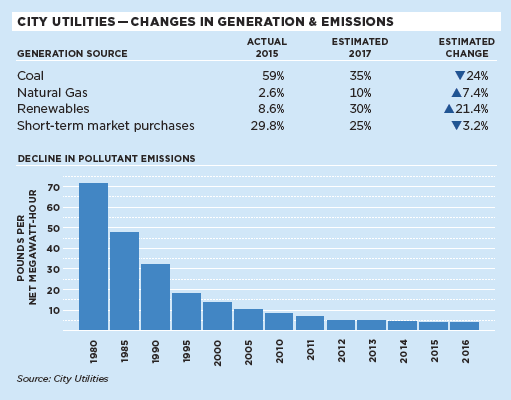NATURAL ENVIRONMENT

Water and air quality remain strong in the Springfield area. Sustaining that success, however, demands substantial investment and commitment in the years ahead.
- Innovative integrated planning
- Water and air quality
- An expanding trail and greenways system
- Education and protection efforts
- Uncertainty of regulation, agency support
- Stormwater management funding
- Drinking-water supply
Springfield's natural environment boasts a number of features for residents and visitors: Clear streams, lakes, and rivers offering several species of game fish; healthy forests; distinctive prairies, glades, and wetlands; hiking, biking, and walking. The area offers some of the nation's best fishing, cleanest air, most beautiful karst features—unusual caves, mysterious sinkholes, rock outcroppings—rugged but fragile icons of Ozarks living.
Citizen volunteer groups, businesses, institutions, government agencies and quasi-government organizations work together to preserve, protect, educate and foster awareness and enjoyment of our outdoors, balancing these efforts against the reality of a community struggling with poverty, expensive infrastructure needs, and limited human and economic resources.
BLUE
RIBBONS

As noted in the 2015 Community Focus Report, Springfield was one of first communities in the United States to adopt an integrated approach to the overwhelming total cost (estimated at $1.6 billion) of meeting environmental compliance responsibilities and infrastructure needs. The City of Springfield, Greene County, and City Utilities of Springfield, work with the Missouri Department of Natural Resources, the U.S. Environmental Protection Agency, local agencies, and citizen volunteer organizations to determine how best to spend each limited dollar in the most effective manner to meet community needs.
Maintaining water and air quality remains a priority for the area. Millions of dollars come to our region as a direct result of our ability to maintain high-quality water in surrounding rivers, lakes, and streams. Active citizen groups, such as Watershed Committee of the Ozarks and the James River Basin Partnership, have been protecting water quality for decades and serve as ready sources of educational information, hands-on educational opportunities, and technical and research assistance.
 Springfield continues to meet federal air-quality standards for ground-level ozone and fine particulate matter. The Ozarks Clean Air Alliance, which includes stakeholders in a 15-county area in southwest Missouri, work with local community leaders and media to raise awareness of air-quality concerns and promote proactive practices such as education, commuting, and ridesharing programs, to reduce air pollution. Infrastructure improvements and alternative (non-coal) fuel choices instituted by CU have played a significant role in good air quality.
Springfield continues to meet federal air-quality standards for ground-level ozone and fine particulate matter. The Ozarks Clean Air Alliance, which includes stakeholders in a 15-county area in southwest Missouri, work with local community leaders and media to raise awareness of air-quality concerns and promote proactive practices such as education, commuting, and ridesharing programs, to reduce air pollution. Infrastructure improvements and alternative (non-coal) fuel choices instituted by CU have played a significant role in good air quality.
Continuing the long-range improvement plan, Springfield's investments in wastewater treatment-plant capacity and pipe efficiency have resulted in impressive returns on ratepayers' dollars invested. Improvements led to documented reductions in stormwater entering the sewage system, which creates unnecessary volumes for treatment.
Public-sector support combined with the long-standing volunteer support and recent successful $700,000 capital campaign of Ozark Greenways resulted in the continuing expansion of Springfield's trail system.
Area students and adults also have access to a wealth of environmental education resources. Informal education partners such as the Springfield Conservation Nature Center (Missouri Department of Conservation) and the Springfield-Greene County Botanical Center (Springfield-Greene County Parks Department) provide hands-on learning experiences to students and teachers. Such efforts are at the core of connecting students of all ages to various aspects of the environment.
Springfield continues to be recognized as a leader in tree preservation. The city, which has a dedicated policy on the issue, has strong volunteer support through the Tree City USA Citizens Advisory Committee and Ozark Greenways, and the Arbor Day Foundation has awarded numerous accolades to the city, which has been named a Tree City USA for 31 years. In addition, CU has been named a Tree Line USA Utility for 22 years, while Missouri State and Drury universities have been designated as tree campuses for three years each. The city's arboretum at the Springfield-Greene County Botanical Gardens has received international accreditation, and Springfield has joined the Mayor's Monarch Pledge as a monarch butterfly and pollinator-friendly community.
RED
FLAGS

Like other municipalities, Springfield faces uncertainty with regard to regulation and funding. As Springfield works to address the long-term and chronic effects of poverty, the competition for community resources continues. The funding required to meet the environmental responsibilities and requirements ($1.6 billion) add to the staggering total of the community's overall financial needs.
Environmental issues and the agencies and organizations that deal with them have become caught up in the current fractured political discourse. Extremes in any direction pose a threat to the health of our natural environment and to the ability of regulated communities to maintain consistent, effective efforts toward balancing community resources and the cost of meeting regulatory requirements. In addition, weather extremes have become the norm, and planning efforts—including significant capital requirements and adjustments in emergency response preparedness—are required as a result.
Since 2005, the Community Focus Report has identified the lack of adequate, long-term funding for stormwater management in Springfield and Greene County as a red flag. Funding is needed to address aging infrastructure and flooding. The city must also invest to keep its storm-sewer system permits in regulatory compliance.
Concerns regarding long-term regional water supplies were first articulated in the 2009 Community Focus Report and remain. While Springfield is well-positioned to deal with future drinking-water requirements for our citizens, many neighboring communities are not. The Tri-State Water Resource Coalition, which includes Springfield, Greene County, and CU, is exploring whether Springfield should become a regional supply source.
Community Voices
Students at Missouri State University gathered input from the Springfield citizens via Padlet. Respondents focused upon the natural beauty of the area in and around Springfield.
"The most important investment we can make for any public improvement is to consider our impacts on the community's environment. Clean air, water and healthy neighborhoods should be our goal to bring about a strong economy, retention of workforce and an attraction for growth. Protecting the environment is no longer a part-time job or a special event. Today protecting the environment requires everyone in the game with all parties at the table and all concerns respected. It's a big task but we all have one backyard and that's a good place to start."
— TERRY WHALEY
EXECUTIVE DIRECTOR,
OZARK GREENWAYS
For current information on Springfield's environment, visit CARES Engagement Network.

